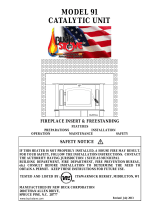
INSTALLATION PROCEDURE (Use a Listed Direct or Positive Connect) Not Shown
FIGURE 2 POSITIONING
4. Mount the side trim panels. (See Figure 3.)
a. Position the trim panel on the reference line.
b. Drill mounting holes in center of trim panel mounting brackets to allow for adjustment in
and out if necessary.
c. Mount the trim panel using the self-tapping screws provided.
5. Place top panel back on reference mark. Take top trim panel mounting bracket supplied with unit. Position
bracket so it overlaps rear lip of top trim panel. Drill mounting holes in top of stove using holes in bracket as
guide. Tighten down screws.
6. Now, follow the installation procedures in the listed direct connect or positive connect kit you are using and
install the heater and connect kit in the fireplace. If not using direct connect kit, continue.
7. Slide the unit back into the fireplace. Check to be sure that the trim panels are properly positioned and lie flat
against the front of the fireplace. If one or more of the panels is out of position, slide the unit out and reset by
loosening the mounting screws and repositioning in the slot.
8. Reinstall the top trim panel by sliding the rear lip of the top trim panel underneath the front lip of the mounting
bracket already secured to top of unit.
POSITIONING THE HEATER
NOTE: It is not necessary to direct connect this unit
unless installed in an improperly drawing fireplace or
oversized flue. It is recommended a chimney connector
be installed from the appliance flue collar to the first
fireplace chimney section.
When positioning the heater, the following conditions
MUST be met! (See Figure 2)
1. The front of the damper opening must be positioned
BEHIND the rear edge of the lintel to ensure proper
draft. (See Figure 2)
2. Center the heater in the fireplace opening.
MOUNTING THE TRIM PANELS
After the unit is positioned, mark the mounting position
of the trim panels as follows:
1. Set the side trim panels in place, flat against the
face of the fireplace. Mark down the front edge of
the trim panel with a pencil to make a vertical
reference line. (See Figure 3.)
2. Set the top (long) trim panel in place on top
of the unit. The panel should be flat against the
outside face of the fireplace, and standing vertically.
Mark along the lower edge of the trim panel with a
pencil to make a reference line for mounting.
3. Slide the unit out of the fireplace far enough to work
behind the trim panel reference lines.
FIGURE 3 MOUNTING TRIM PANELS
































